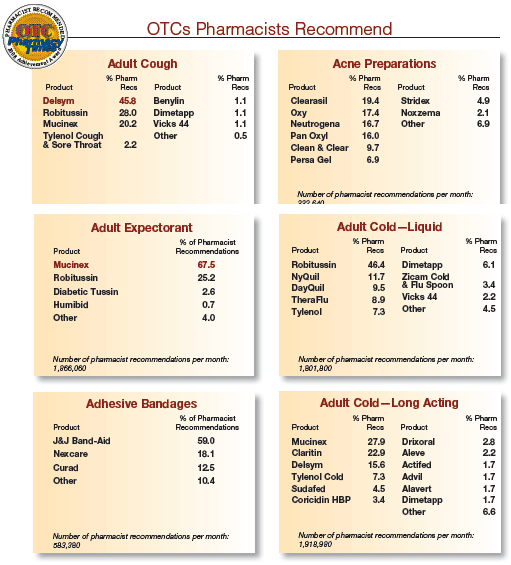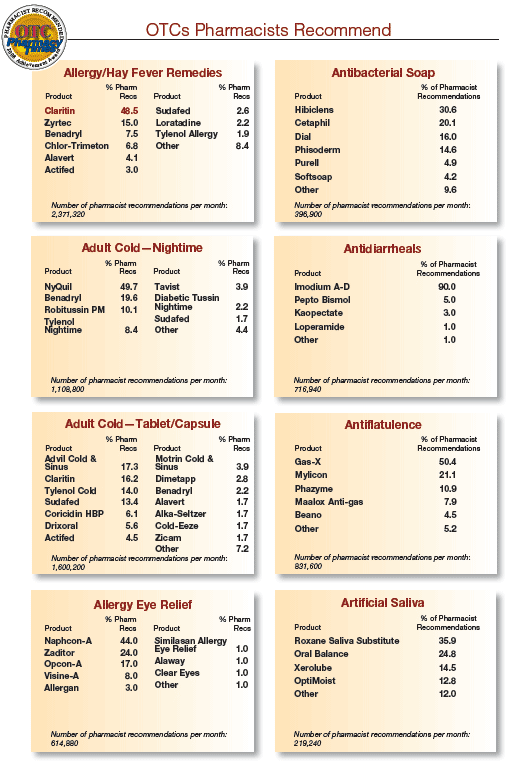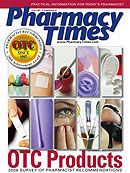Patients' Needs Guide OTC Recommendations
Mr. Lamb is a freelance pharmacy writer living in Virginia Beach and president of Thorough Cursor Inc.
It is always enlightening to pick up this annual supplement and learn which OTCs are most often recommended to patients by pharmacists. This article goes a little deeper to provide some insight into why certain products are recommended.
The short answer is that pharmacists base their recommendations on a patient's symptoms, current medications, past experiences, and economic situation. This is unsurprising, but also very beneficial for patients.
Trusted Medication Advisors
Information about OTC medications abounds. A recent breakdown of ways patients can learn about products included packaging, friends or family, store signage, manufacturers' Web sites, instore kiosks, online search engines, product review sites, and social networking sites.1
As empowering as this can be, individuals are still very likely to turn to pharmacists when deciding which OTC product is best for them or their child.2 In 2006, a survey revealed that 83% of US adults commonly ask pharmacists about medications. An earlier survey found that 60% of consumers want pharmacists to advise themabout OTCs.3
Asmaa Bazzi, PharmD, who manages a CVS/pharmacy in Fort Myers, Florida, estimates that between 10 and 15 patients approach her each day for help with selecting OTCs. "A lot of the people come in because their family or friends told them that I could help," Dr. Bazzi said. "Because I was able to answer all the questions for one person,they tell others that I can help them feel better."
Across the country, Tanya Scalise-Manoni, PharmD, a staff pharmacist at Target in American Fork, Utah, also consults with 10 to 20 patients each day regarding OTCs. A majority of Dr. Scalise-Manoni's patients are young parents, and she said, "All the time, I will have mothers come up to me and say, 'I can't find the yellow Triaminic [guaifenesin and phenylephrine]. My pediatrician told me I need to get the yellow Triaminic.'"
According to Dr. Scalise-Manoni, "These kinds of openings are great, because they let me dig deeper into what the medication they are looking for is going to be used for. Maybe the yellow Triaminic is not what the kid needs if she already has a runny nose."

Figuring Out What to Recommend
Both Drs. Bazzi and Scalise-Manoni said that the first thing they try to determine before recommending any OTC medication is what symptoms are going to be treated. They also ask about other medications the patient is currently taking and, when the patient is a regular, check their pharmacy records for possible interactions and allergies.
The pharmacists also consider cost. Dr. Scalise-Manoni said, "I always take cost effectiveness into account. When there is no difference between the store brand and the name brand, I will ask patients to consider the store brand." She added, however, that when she hears back from patients that a generic does not work as well as its brandedequivalent, she recommends the brand. "Cost is a concern, but what really counts is that a medication makes patients feel better," she said.
Dr. Bazzi takes a slightly different approach to cost considerations. When multiple options exist, such as with combination cough and cold treatments, she will go over the benefits and possible risks of the different combinations and then mention what the products cost. "I always try to follow up with patients who buy OTCs, though, to make sure that whatever they chose worked for them."
References
- Consumer Trend Watch 2008: Shifting Consumer Expectations Are Changing the Game. Information Resources Inc. Available at: us.infores.com/~TT_February_2008_Trends_to_Watch.pdf. Accessed May 13, 2008.
- 2006 Pharmacy Satisfaction Digest. Boehringer Ingelheim Pharmaceuticals Inc. Available at: www.pharmacysatisfaction.com/~PharmacistServices.pdf. Accessed May 13, 2008.
- Troy M. Pharmacists have become OTC allies. Drug Store News. June 26, 1995. Available at: findarticles.com/p/articles/mi_m3374/is_n9_v17/ai_17158292. Accessed May 13, 2008.


